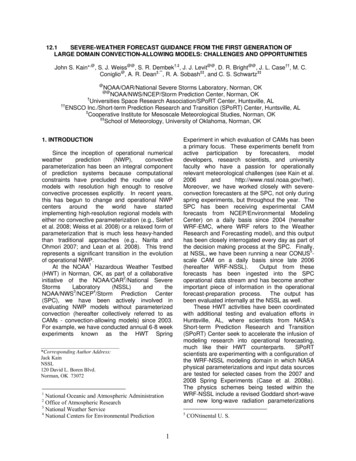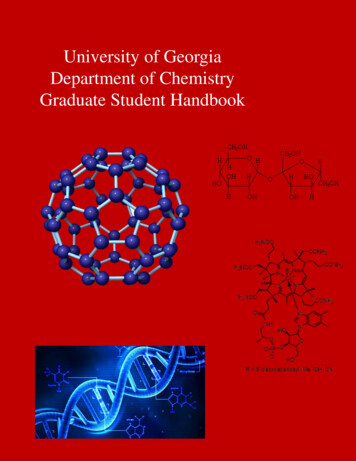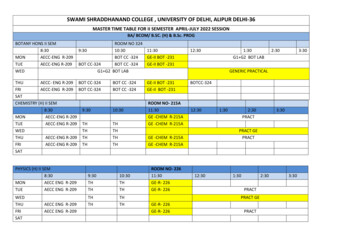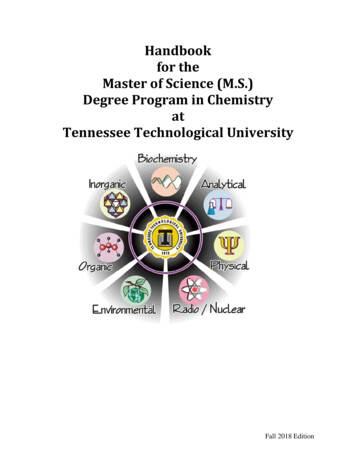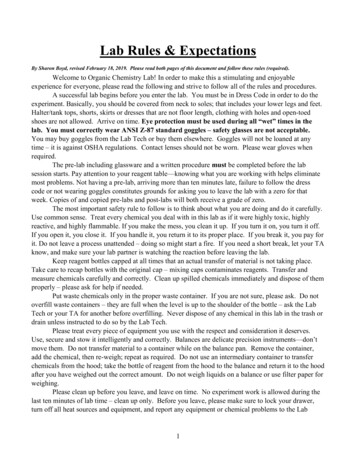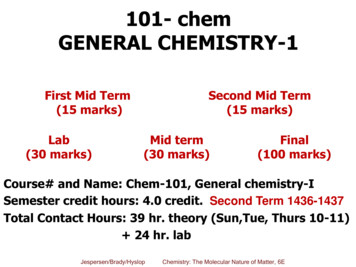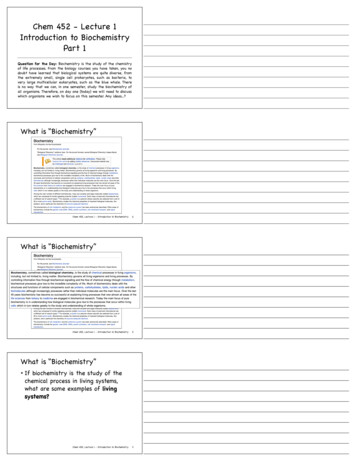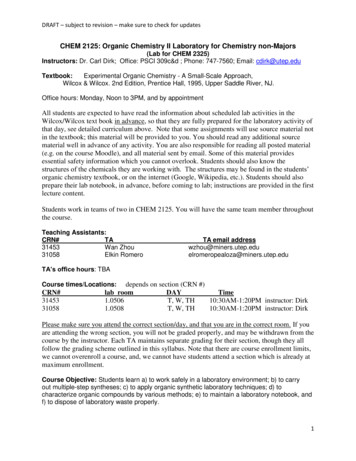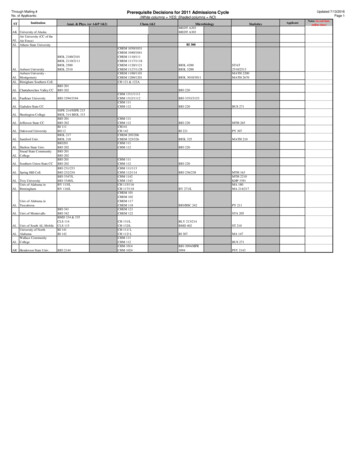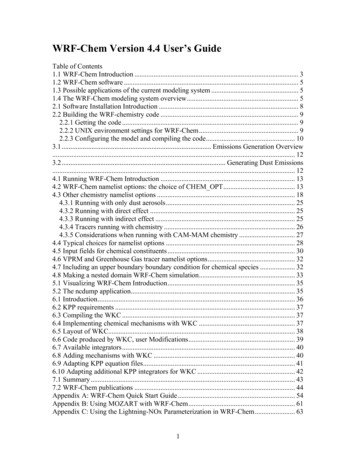
Transcription
WRF-Chem Version 4.4 User’s GuideTable of Contents1.1 WRF-Chem Introduction . 31.2 WRF-Chem software . 51.3 Possible applications of the current modeling system . 51.4 The WRF-Chem modeling system overview . 52.1 Software Installation Introduction . 82.2 Building the WRF-chemistry code . 92.2.1 Getting the code . 92.2.2 UNIX environment settings for WRF-Chem . 92.2.3 Configuring the model and compiling the code . 103.1 . Emissions Generation Overview. 123.2 . Generating Dust Emissions. 124.1 Running WRF-Chem Introduction . 134.2 WRF-Chem namelist options: the choice of CHEM OPT . 134.3 Other chemistry namelist options . 184.3.1 Running with only dust aerosols . 254.3.2 Running with direct effect . 254.3.3 Running with indirect effect . 254.3.4 Tracers running with chemistry . 264.3.5 Considerations when running with CAM-MAM chemistry . 274.4 Typical choices for namelist options . 284.5 Input fields for chemical constituents . 304.6 VPRM and Greenhouse Gas tracer namelist options . 324.7 Including an upper boundary boundary condition for chemical species . 324.8 Making a nested domain WRF-Chem simulation . 335.1 Visualizing WRF-Chem Introduction . 355.2 The ncdump application . 356.1 Introduction . 366.2 KPP requirements . 376.3 Compiling the WKC . 376.4 Implementing chemical mechanisms with WKC . 376.5 Layout of WKC. 386.6 Code produced by WKC, user Modifications . 396.7 Available integrators . 406.8 Adding mechanisms with WKC . 406.9 Adapting KPP equation files. 416.10 Adapting additional KPP integrators for WKC . 427.1 Summary . 437.2 WRF-Chem publications . 44Appendix A: WRF-Chem Quick Start Guide . 54Appendix B: Using MOZART with WRF-Chem . 61Appendix C: Using the Lightning-NOx Parameterization in WRF-Chem . 631
Appendix D: Using TUV photolysis with WRF-Chem .672
WRF-Chem OverviewTable of Contents1.1 WRF-Chem Introduction . 31.2 WRF-Chem software . 51.3 Possible applications of the current modeling system . 51.4 The WRF-Chem modeling system overview . 51.1 WRF-Chem IntroductionThe WRF-Chem User’s Guide is designed to provide the reader with informationspecific to the chemistry part of the WRF model and its potential applications. It willprovide the user a description of the WRF-Chem model and discuss specific issuesrelated to generating a forecast that includes chemical constituents beyond what istypically used by today’s meteorological forecast models. For additional informationregarding the WRF model, the reader is referred to the WRF model User’s r guide v4/contents.html).Presently, the WRF-Chem model is now released as part of the Weather Researchand Forecasting (WRF) modeling package. And due to this dependence upon WRF, it isassumed that anyone choosing to use WRF-Chem is very familiar with the set-up and useof the basic WRF model. It would be best for new WRF users to first gain training andexperience in editing, compiling, configuring, and using WRF before venturing into themore advanced realm of setting up and running the WRF-Chem model.The WRF-Chem model package consists of the following components (inaddition to resolved and non-resolved transport) as well as some additional unlistedcapabilities:§ Dry deposition (and gravitational settling for some species and chemistry options),coupled with the soil/vegetation scheme§ Five choices for biogenic emissions: No biogenic emissions included Online calculation of biogenic emissions as in Simpson et al. (1995) and Guentheret al. (1994) includes emissions of isoprene, monoterpenes, and nitrogenemissions by soil Online modification of user-specified biogenic emissions - such as the EPABiogenic Emissions Inventory System (BEIS) version 3.14. The user mustprovide the emissions data for their own domain in the proper WRF data fileformat Online calculation of biogenic emissions from MEGAN v2.0 Online calculation of biogenic emissions from MEGAN v2.1 (must use CLM)§ Several choices for anthropogenic emissions: No anthropogenic emissions3
Global emissions data from the one-half degree RETRO and ten-degree EDGAR§§§§data sets User-specified anthropogenic emissions such as those available from the U.S.EPA NEI-05 and NEI-11 data inventories. The user must provide the emissionsdata for their own domain in the proper WRF data file format. Several tools exist to create emissions and can be found on NCAR’s f-chem/wrf-chem-toolscommunity). HERMES: A stand-alone multi-scale emission modeling framework that cancurrently can process EDGAR, CEDS, ECLIPSE, HTAP, GFAS, EMEP,TNO MACC-iii, Carn et al (Volcanoes), and Wiedinnmyer et al (trash burning)Several choices for gas-phase chemical mechanisms including: RADM2, RACM, CB05, CB-4, CBM-Z, NMHC9, SAPRC-99, MOZART, andCRIMECH chemical mechanisms The use of the Kinetic Pre-Processor, (KPP) to generate the chemicalmechanisms. The equation files (using Rosenbrock type solvers) are currentlyavailable for RADM2, RACM, RACM-MIM, SAPRC-99, MOZART, NMHC9,CRIMECH, CB05, CBMZ, and CB-4 chemical mechanismsFour choices for photolysis schemes: Madronich scheme coupled with hydrometeors, aerosols, and convectiveparameterizations. This is a computationally intensive choice, tested with manysetups Fast-J photolysis scheme coupled with hydrometeors, aerosols, and convectiveparameterizations F-TUV photolysis scheme. This scheme, also from Sasha Madronich, is fasterthan the previous Madronich scheme option. TUV photolysis scheme based on standalone TUV version 5.3, has updated crosssection, quantum yield datasets that cover 109 photolysis rates. Currently thischoice is only coupled to MOZART mechanism, but users can easily adapt thesource code for other mechansims (see Appendix 4)Five choices for aerosol schemes: The Modal Aerosol Dynamics Model for Europe - MADE/SORGAM The Modal Aerosol Dynamics Model for Europe with the Volitity Basis Setaerosols – MADE/VBS The Modal Aerosol Module (MAM) 3 or 7 bin schemes closely coupled to theCAM5 physics The Model for Simulating Aerosol Interactions and Chemistry (MOSAIC - 4 or 8bins) sectional model aerosol parameterization A bulk aerosol module from GOCARTAerosol direct effect through interaction with atmospheric radiation, photolysis, andmicrophysics routines. This is available for all aerosol options starting with version3.54
§ Aerosol indirect effect through interaction with atmospheric radiation, photolysis, and§§§§microphysics routines. This feature is available for modal and sectional aerosoloptions starting with version 3.5.An option for the passive tracer transport of greenhouse gasesTwo options for a 10-bin volcanic ash aerosol scheme based upon emissions from asingle active volcano. One scheme includes SO2 degassing from the volcano whilethe other ignores SO2 degassing. Volcanic ash emissions can also be coupled to someaerosol modules (bulk and modal)A tracer transport option in which the chemical mechanism, deposition, etc. has beenturned off. The user must provide the emissions data for their own domain in theproper WRF data file format for this option. May be run parallel with chemistryA plume rise model to treat the emissions of wildfires1.2 WRF-Chem softwareThe chemistry model has been built to be consistent with the WRF model I/OApplications Program Interface (I/O API). That is, the chemistry model section has beenbuilt following the construction methodology used in the remainder of the WRF model.Therefore, the reader is referred to the WRF software description in the WRF User’sGuide (Chapter 7) for additional information regarding software features like the buildmechanism and adding arrays to the WRF registry. And while the chemistry model hasbeen built with the intent to work within the WRF framework, not all run time options(e.g., physical parameterizations) that are available for WRF will function properly withchemistry turned on. Therefore, care must be taken in selecting the parameterizationsused with the chemistry schemes.1.3 Possible applications of the current modeling system§Prediction and simulation of weather, or regional and local climate§Coupled weather prediction/dispersion model to simulate release and transport ofconstituents§Coupled weather/dispersion/air quality model with full interaction of chemicalspecies with prediction of O3 and UV radiation as well as particulate matter (PM)§Study of processes that are important for global climate change issues. Theseinclude, but are not restricted to the aerosol direct and indirect forcing1.4 The WRF-Chem modeling system overviewThe following figure shows the flowchart for the WRF-Chem modeling systemversion 4.4.5
As shown in the diagram, the WRF-Chem modeling system follows the same structure asthe WRF model by consisting of these major programs:§§The WRF Pre-Processing System (WPS)WRF-Var data assimilation system6
§§WRF solver (ARW core only) including chemistryPost-processing and visualization toolsThe difference with regular WRF comes from the chemistry part of the model needing tobe provided additional gridded input data related to emissions. This additional input datais provided either by the WPS (dust emission fields), or read in during the real.exeinitialization (e.g., biomass burning, biogenic emissions, GOCART background fields,etc.), or read in during the execution of the WRF solver (e.g., anthropogenic emissions,boundary conditions, volcanic emissions, etc.). And while some programs are provided inan attempt to aid the user in generation of these external input data files, as stated earlier,not all emissions choices are set-up to function for all possible namelist options related tothe WRF-Chem model. In other words, the generation of emissions input data forsimulating the state of the atmosphere’s chemistry can be incredibly complex. Sometimes the user will need to modify code, or the model configuration, to get it to functionproperly for their project. For more information regarding the input of emissions thereader is directed to the WRF-Chem Emissions Guide.7
Chapter 2: WRF-Chem Software InstallationTable of Contents2.1 Software Installation Introduction . 82.2 Building the WRF-chemistry code . 92.2.1 Getting the code . 92.2.2 UNIX environment settings for WRF-Chem . 92.2.3 Configuring the model and compiling the code . 102.1 Software Installation IntroductionThe WRF modeling system software (including chemistry) installation is straightforward on the ported platforms. The package is mostly self-contained, meaning thatWRF requires no external libraries that are not already supplied with the code. Oneexception for WRF is the netCDF library, which is one of the supported I/O APIpackages. The netCDF libraries or source code are available from the Unidata homepageat http://www.unidata.ucar.edu (select the pull-down tab Downloads, registrationrequired, to find the netCDF link). Likewise, there is one exception as well, the fastlexical analyser (FLEX) library (libfl.a) will be needed if compiling the KPP chemistrycode. This library is commonly included with GNU bison and is freely available fordownload at http://www.gnu.org/software/bison if it is not already installed on your unixsystm.The WRF-Chem model has been successfully ported to a number of Unix-basedmachines. We do not have access to all tested systems and must rely on outside users andvendors to supply required configuration information for compiler and loader options ofcomputing architectures that are not available to us. See also chapter 2 of the User’sGuide for the Advanced Research WRF for a list of the supported combinations ofhardware and software, required compilers, and scripting languages as well as postprocessing software. It cannot be guaranteed that chemistry will build successfully on allarchitectures that have been tested for the meteorological version of WRF.Note that this document assumes a priori that the reader is very familiar with theinstallation and implementation of the WRF model and its initialization package (e.g., theWRF Preprocessing System, or WPS). Documentation for the WRF Model and itsinitialization package can be found at (http://www2.mmm.ucar.edu/wrf/users/pubdoc.html). With this assumption in place, the remainder of this chapter provides a quickoverview of the methodology for downloading the WRF-Chem code, setting the requiredenvironmental variables, and compiling the WRF-Chem model. Subsequent chaptersassume that the user has access to the WRF-Chem model- and emission-data sets for theirregion of interest and has them readily available so that a full weather and chemicaltransport simulation can be conducted.8
2.2 Building the WRF-chemistry code2.2.1 Getting the codeTo obtain the WRF-Chem model one should follow these steps:--- For WRF versions 4.0 :§Clone the source code from the public(https://github.com/wrf-model/WRF): git clone https://github.com/wrf-model/WRF cd WRFGithubrepository--- For WRF versions prior to 4.0§Download, or copy to your working space, the WRF zipped tar file. The WRF model and the chemistry code directory are available from theWRF model download web site (http://www2.mmm.ucar.edu/wrf/users) The chemistry code is a separate download from the WRF modeldownload web page and can be found under the WRF-Chemistry code title Always get the latest version if you are not trying to continue a longproject Check for known bug fixes for both WRF and WRF-Chem by examiningthe WRF and WRF-Chem web pages Unzip and untar the file gzip –cd WRFV3-Chem-3.9.TAR tar –xf – Again, if there is a newer version of the code use it, 3.9 is used only as anexample cd WRFV3Remember that bug fixes become available on a regular basis and can be updated viaGithub by checking out the latest branch. You should check the WRF Github web pagefrequently for updates on bug fixes. This includes also updates and bug fixes for themeteorological WRF code.2.2.2 UNIX environment settings for WRF-ChemBefore building the WRF-Chem code, several environmental settings are used tospecify whether certain portions of the code need to be included in the model build. In cshell syntax, the important environmental settings are:setenv EM CORE 1setenv NMM CORE 09
and they explicitly define which model core to build. These are the default values that aregenerally not required. The environmental settingsetenv WRF CHEM 1explicitly defines that the chemistry code is to be included in the WRF model build, andis required for WRF-Chem. This variable is required at configure time as well as compiletime.Optionally,setenv WRF KPP 1setenv YACC ‘/usr/bin/yacc –d’setenv FLEX LIB DIR /usr/local/libexplicitly defines that the Kinetic Pre-Processor (KPP) (Damian et al. 2002; Sandu et al.2003; Sandu and Sander 2006) is to be included in the WRF-Chem model build using theflex library (libfl.a). In our case, the flex library is located in /usr/local/lib and compilesthe KPP code using the yacc (yet another compiler) location in /usr/bin. This is optionalas not all chemical mechanisms need the KPP libraries built during compilation. Theuser may first determine whether the KPP libraries will be needed (see chapter 6 for adescription of available options). One should set the KPP environmental variable to zero(setenv WRF KPP 0) if the KPP libraries are not needed.2.2.3 Configuring the model and compiling the codeThe WRF code has a fairly complicated build mechanism. It tries to determine thearchitecture that you are on, and then present you with options to allow you to select thepreferred build method. For example, if you are on a Linux machine, the code mechanismdetermines whether this is a 32-or 64-bit machine, and then prompts you for the desiredusage of processors (such as serial, shared memory, or distributed memory) andcompilers. Start by selecting the build method:§ ./configure§Choose one of the options Usually, option "1" is for a serial build. For WRF-Chem do not use theshared memory OPENMP option (smpar, or dm sm) as these optionsare not supported. The serial build is a preferred choice if you aredebugging the program and are working with very small data sets (e.g. ifyou are developing the code). Since WRF-Chem uses a lot of memory(many additional variables), the distributed memory options are preferredfor all other cases§You can now compile the code using ./compile em real & compile.log10
§If your compilation was successful, you should find the executables in the“main” subdirectory. You should see ndown.exe, real.exe, and wrf.exe listed ls -ls main/*.exeAt this point all of the WRF-Chem model have been built. The model can be runand the run time messages should indicate that chemistry is included. But before one canuse the WRF chemistry model to its full potential, the emissions input data needs to begenerated. The manufacturing of the emissions input data is the subject of the nextchapter and the WRF-Chem Emissions Guide.11
Chapter 3: Generation of WRF-Chem-Emissions DataTable of Contents3.1 . Emissions Generation Overview. 123.2 . Generating Dust Related Emissions. 123.1 Emissions Generation OverviewOne of the main differences between running with and without chemistry is theinclusion of additional data sets describing the sources of chemical species. Ideally therewould be single model, or utility code that would construct any and all emissions datasets for any domain and any chemistry option that a user selects. Unfortunately this is notthe case and some of the emission files need to be prepared externally from the WRFChem simulation. This places the requirement the WRF-Chem model user toconstruct the emissions data set for your particular domain and desired chemistryoption from the wide variety of available data sources. This also places the WRFChem user in a position of needing to understand the complexity of their emissions dataas well as having the control over how the chemicals are speciated and mapped to theirsimulation domain. While this can be a daunting task to the uninitiated, a separate guidehas been written that should help illustrate the methodology through which emissionsdata is generated for a forecast domain. In short, there are several utility programs anddata sets provided by the WRF-Chem user community that may be used to create anemissions data set. There are some restrictions on the domain location and the choice ofchemical mechanism that need to be considered when using these programs. See theseparate WRF-Chem emissions document to learn more about these programs and theiruse.3.2 Generating Dust EmissionsAdding dust aerosols to a WRF simulation is perhaps the easiest of all WRFChem options as the model generates the dust emissions fields during the actual run. The“online” dust emissions data is provided through land useage information produced bythe WRF Preprocessing System (WPS) and the simulated meteorological fields. Hence,by compiling the WRF-Chem code, and following standard procedures of using the WPSto generate the WRF-Chem model input data, the user has the added option of includingan aerosols scheme with minimal effort. Additional information about running with dustaerosols is available in Chapter 4 as well as under the tutorials link from the WRF-Chemweb page at https://ruc.noaa.gov/wrf/wrf-chem/.12
Chapter 4: Running the WRF-Chemistry ModelTable of Contents4.1 Introduction: Running WRF-Chem . 134.2 WRF-Chem namelist options: the choice of CHEM OPT . 134.3 Other chemistry namelist options . 184.3.1 Running with only dust aerosols . 254.3.2 Running with direct effect . 254.3.3 Running with indirect effect . 254.3.4 Tracers running with chemistry . 264.3.5 Considerations when running with CAM-MAM chemistry . 274.4 Typical choices for namelist options . 284.5 Input fields for chemical constituents . 304.6 VPRM and Greenhouse gas tracer namelist options. 324.7 Including an upper boundary boundary condition for chemical species . 324.8 Making a nested domain WRF-Chem simulation . 334.1 Running WRF-Chem IntroductionAfter successful construction of the anthropogenic- and biogenic-emission-inputdata files, it is time to run the model. This process is no different than running themeteorological version of the model. To make an air-quality simulation, change directoryto the WRF/test/em real directory. In this directory you should find links to theexecutables real.exe, and wrf.exe, other linked files, and one or more namelist.input filesin the directory.For larger domain simulations, one should use a DM (distributed memory)parallel system to make a forecast. This is of particular importance for WRF-Chem sincemuch additional memory is required.4.2 WRF-Chem namelist options: the choice of CHEM OPTThe largest portion of the chemistry namelist options are related to the chemicalmechanisms and aerosol modules selection. The mechanism used during the forecast isdecided with the namelist parameter chem opt is described next. Some of these choicesrequire other settings for other namelist options. The options that are printed with redlettering indicate those options that are not fully implemented and tested. Model usersare discouraged from selecting those options as they are not fully supported and couldproduce erroneous, or in the extreme case, detrimental results. In addition, it should bepointed out that the model developers most often work with just a few options at one time(e.g., RADM2/MADE-SORGAM, CBMZ/MOSAIC). Not all of the other availableoptions are tested during development, but often it is a trivial exercise to make the otheroptions functional. Therefore, users are encouraged to determine their desired settingsthat works best for their simulation, test the namelist combination, improve the model13
code, and then communicate the improvements to the WRF-Chem user community. Thechem opt namelist parameter is organized according to the chemical mechanism that variablechem opt 0 no chemistry 1includes chemistry using the RADM2chemical mechanism - no aerosols 2includes chemistry using the RADM2chemical mechanism andMADE/SORGAM aerosols. 5CBMZ chemical mechanism withDimethylsulfide, or DMS 6CBMZ chemical mechanism withoutDMSCBMZ chemical mechanism 7(chem opt 6) and MOSAIC using 4sectional aerosol bins.CBMZ chemical mechanism 8(chem opt 6) and MOSAIC using 8sectional aerosol bins. 9CBMZ chemical mechanism(chem opt 6) and MOSAIC using 4sectional aerosol bins including someaqueous reactions 10CBMZ chemical mechanism(chem opt 6) and MOSAIC using 8sectional aerosol bins including someaqueous reactions 11RADM2 chemical mechanism andMADE/SORGAM aerosols includingsome aqueous reactions 12RACM chemical mechanism andMADE/SORGAM aerosols includingsome aqueous reactions 13Run with 5 tracers with emissions,currently set up for SO2, CO, NO, ald,hcho, ora2 14Single tracer run using tracer 1 array 15Ensemble tracer option using 20individual tracers and an ensemble tracerarray 16Greenhouse gas CO2 only tracers14Additional CommentsDue to errors, dust opt 2, seas opt 2has been disabled.Due to errors, dust opt 2, seas opt 2has been disabled.Due to errors, dust opt 2, seas opt 2has been disabled.Due to errors, dust opt 2, seas opt 2has been disabled.Use of tracer opt suggested instead ofthis option.Use of tracer opt suggested instead.Use of tracer opt suggested instead.Use of tracer opt might be a betterchoice in some cases
17 30 31 32 33 34 35 41 42 43 100 101 102Greenhouse gas tracers for CO2, CH4CBMZ chemical mechanism(chem opt 6) and MADE/SORGAMmodal aerosolCBMZ chemical mechanism(chem opt 6) and MOSAIC using 4sectional aerosol bin with dmsCBMZ chemical mechanism with(chem opt 6) and MOSAIC using 4sectional aerosol bins with dms. Someaqueous reactions includedCBMZ chemical mechanism(chem opt 6) and MOSAIC using 8sectional aerosol bin with dms. Someaqueous reactions includedCBMZ chemical mechanism with(chem opt 6) and MOSAIC using 8sectional aerosol bins with dms. Someaqueous reactions included.CBMZ chemical mechanism(chem opt 6) and MADE/SORGAMmodal aerosol. Some aqueous reactionsincludedRADM2/SORGAM with aqueousreactions included.RACM/SORGAM with aqueousreactions included (KPP)NOAA/ESRL RACM Chemistry andMADE/VBS aerosols using KPP library.The volatility basis set (VBS) is used forSecondary Organic AerosolsRACM Chemistry with MADE/VBSaerosols using KPP library along with thevolatility basis set (VBS) used forSecondary Organic Aerosols andheterogenous reactionsRADM2 Chemistry using KPP library 103RACM-MIM Chemistry using KPPlibraryRACM Chemistry using KPP library 104RACM Chemistry and PM advection15Includes less complex aqueousreactions following CMAQ
5 § Aerosol indirect effect through interaction with atmospheric radiation, photolysis, and microphysics routines. This feature is available for modal and sectional aerosol options starting with version 3.5. § An option for the passive tracer transport of greenhouse gases § Two options for a 10-bin volcanic ash aerosol scheme based upon emissions from a
